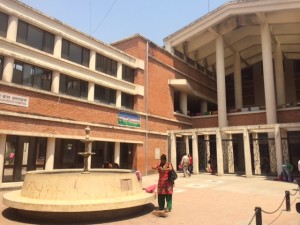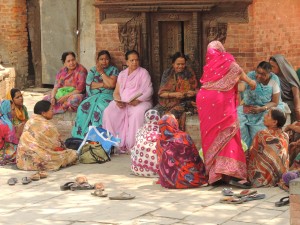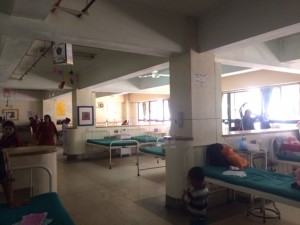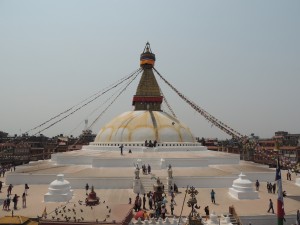Namaste!! I made it here to Nepal safe and sound despite the fact my body clock was a little out of whack after so many hours of flying! Boy oh boy what a culture shock it was to arrive in Kathmandu! I don’t think I could have picked two more opposite places to go to for my elective. After the quiet, isolated and laid-back life in the Falklands the hustle and bustle of the capital of Nepal was rather overwhelming!
After checking through immigration I was bundled into a car to be taken to my accommodation. The chaos of Nepal driving insued! It is just as you see on TV with trucks, buses, cars, tempos, motorbikes and scooters all tooting at each other and swerving to and fro trying to get that one car space ahead. Not to mention the pedestrians who weave in and out of the traffic crossing streets wherever it suits and somehow managing to not get run over!
There are supposed to be road rules but these are generally ignored. Most people drive on the left but if that doesn’t suit then anywhere seems to be just fine. Everyone is quite tolerant though and pedestrians appear to be constantly aware of their surroundings and know when to leap out of the way as a car swerves past them.
On the drive into the heart of the city I was able to have a good look around me. The first thing that struck me was the haze. Kathmandu Valley is surrounded by forested hills with snow-clad mountains in the not too far distance. However these are not visible even from the tallest rooftop. There is a constant blanket of dust and pollution hovering over the expansive city. (This does apparently clear briefly after a downpour but I am yet to experience one of these so I’ll let you know if and when this happens!). Face masks are a must if you ride a motorbike or scooter and many Nepalese wear them when walking through the city as well. It is no surprise that respiratory disease is a major problem here.The sheer number of people was also a little overwhelming! After going for walks in the Falklands where I would see no one all day to being confronted by millions of people all jostling through the winding alleyways of Kathmandu, I almost felt a little out of my depth! It is incredible though, to sit and watch everybody come and go.
The women in their beautiful brightly coloured saris, the men with red tika on their foreheads and traditional Nepali hats and the childrenrunning and darting through the crowds caught up in some high-energy game. Not only people but religion, history and impressive architecture can be found in every corner of this city. Tenth century temples can be found within walking distance of anywhere and ancient shrines are dotted in amongst shops, houses and alleyways. Some demonstrate incredible carvings of Hindu gods, others are decorated with glittering gold adornments or traditional Buddhist inscriptions. All show signs of being a part of everyday life for the Nepali people with offerings of flowers, rice and kumkuma (red paint) scattered around every single one.
Vaisha Dev a shrine dedicated to the God of Toothache. It is believed if you nail a coin to the piece of wood as an offering and say a quick prayer it will help to cure your toothache.
During my time here in Nepal I am working at the Kanti Children’s Hospital. Over 40% of Nepal’s population (of 27 million people) is under the age of 15. Kanti is the only children’s hospital in Nepal so caters for all of those.
Some 65% of patients presenting to Kanti come from outside of the Kathmandu Valley from the rural areas of Nepal. This is due to a lack of adequate healthcare int he rural areas resulting in late presentations and worse burden of disease.
Kanti is a government-funded hospital but the money they receive does not cover the required costs so they rely heavily on fundraising and donations for the upkeep of facilities and resources and to pay over 50% of the staff. Government funding also does not mean the healthcare is free. Patients must pay for each night they stay in the hospital and also for any medical equipment or drugs they require. It is a very different health system compared to back home.

Kanti Children's Hospital, Nepal's only children's hospital. Children (under the age of 15) make up more than 40% of Nepal's population of 27 million people.
If the patient requires admission the doctor will then write out a prescription for all the medical equipment they will require: cannula, IV fluids, medications, blood sampling kits, lumbar puncture kits etc. etc. This script is then given to the family who must go off and purchase the equipment from a shop and bring it back to the hospital for the staff.
If blood, CSF or anything else is collected this will also be given to the family who are required to take it to pathology themselves, then return to the doctor with the results. The patient hold on to all their medical records and x-rays and bring them with them every time they present to hospital. Compare to what I am used to I find this system full of flaws and it seems to cause numerous avoidable delays, but it does somehow seem to work for them.
Nepal is a very poor country though and not everyone is able to afford medical care. Fortunately here at Kanti there is a free-ward where al medical costs are covered if the family is deemed to be unable to afford healthcare.
My first attachment here is with a medical team. After only a couple of days with the team I soon learnt that General Medicine wards are more like Infectious Diseases wards! Gastroenteritis, pneumonia, urinary tract infections, tuberculosis and rheumatic heart disease are the most common things to see on daily ward rounds.It is very hard to see young children come in utterly dehydrated and lifeless after days of vomiting and diarrhoea. Gastroenteritis has always seemed a fairly benign disease in the Western world. Rare to begin with due to adequate clean water supply and good hygiene education and practices, but also easy to treat with IV rehydration and antibiotics if necessary. Here, it seems to be unavoidable.
Water must be purified, something not everyone can afford. Many patients are malnourished to begin with and any fruit, vegetables or meat they do eat all carry potential pathogens. Hygiene is practically non-existent and over-crowding is very common especially in the poorer communities. This so-called benign gastroenteritis can devastate a family within days. Especially if they live rurally where the nearest medical facilities are a three day walk. It is completely heart-breaking to see children die of the easily avoidable diseases.
Another disease that is rather foreign to me and just as devastating is tuberculosis. TB is everywhere here. On my first ward round I saw three cases of pulmonary TB and two with abdominal TB. All in children between the ages of eight and 14.
The thing I found most shocking was that they were all just sitting on the medical ward with every other patient. Each ward room has up to six beds in it with patients and usually all their family living in with them as well. There is no such thing as isolation here! In New Zealand a TB patient would be in strict isolation and to see them would require at least mask, gown and gloves with a lot of hand-washing in between. Here the doctors stroll from one patient to another without even a squirt of alcohol gel. I think NZ infection control officers would have a heart attack if they saw what happened here!
TB treatment is quite up to date here and mostly free of charge as an inpatient. Whilst in hospital the patients receive their medication as required and once their acute exacerbation has run its course they are discharged. However once they are back in the community it is a different story. In New Zealand the medical system ensures you receive your medications and will supervise you taking each pill ito ensure you have the best possible chance of fighting the disease and to help protect the rest of the population.
Community medication dispensing here in Kathmandu is done at an outpatient clinic here at the hospital. This city is a big place and it can take people several hours to get here from their homes, cutting into the valuable working day. Therefore many people do not attend these follow-up appointments and with funds as limited as they are I don’t think much, if any, time and effort is put into tracking people down.
This means the TB is often inadequately treated resulting in progression of disease with very detrimental outcomes. Once again the poor living conditions most people are subjected to here means TB quickly spreads through an entire family.
My first couple of weeks here have certainly been an eye-opener for me. I feel most New Zealanders definitely take their living situations for granted, me inclusive. We are so incredibly lucky to live in a clean and healthy environment where the basic elements of life such as clean water, abundant food and adequate housing are all a fact of life not a rare luxury.
We also have accessible, free healthcare of a very high standard, yet still people find one reason or another to complain. So far, Nepal has definitely brought me back down to earth. I am very thankful that at the end of my elective I will be going back to a safe, healthy home with everything I need for day to day life right at my fingertips.
The same can not be said for millions of people in this world. So if you are reading this while sipping a coffee, checking your emails or just taking a break out of your day, spare at least just a thought for those who are not so lucky as us, and be thankful for what we have.





1 Comment to 'Blog 5: Culture Shock by Rebecca Craw'
October 11, 2014
It’s difficult to find educated people in this particular subject, however, you seem like you know what
you’re talking about! Thanks
Leave a comment